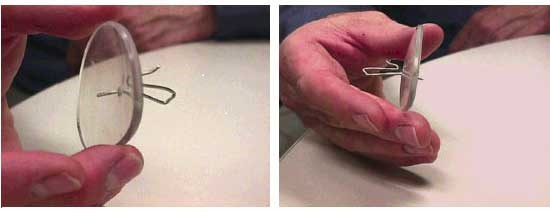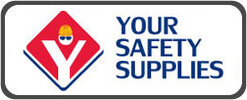Eye Safety Information
How An Eye Was Saved
A private contractor was having a safety glasses program, that so impressed an employee that he began encouraging his eighteen year-old son, who worked installing siding on houses, to wear safety glasses while working. Finally the son f relented, and while on a job, aluminum dust started getting in his eyes.
About one week later, he was applying siding with an air powered staple gun. When the son fired a staple, it hit a metal plate behind the siding, ricocheted back towards his face and one leg of the staple penetrated the safety glasses' lens, (see the figure below). The staple hit with such force that the frames were cracked and the son received bruising on the eyebrow and cheekbone.

The safety glasses definitely saved his eyesight and possibly even his life!
EYE PROTECTION IN THE WORKPLACE
It is estimated that 1,000 eye injuries occur in American workplaces,every day. The financial cost alone of these injuries is enormous—and more than $300 million per year in lost production time, medical expenses, and workers compensation. Yet there is no dollar figure that can adequately reflect the personal toll these accidents take on the injured workers.
And the more than 25 states and territories operating their own job safety and health programs together with The Occupational Safety and Health Administration (OSHA) are determined to help reduce eye injuries.. In concert with efforts by concerned voluntary groups, OSHA has begun a nationwide information campaign to improve workplace eye protection.
. A 1980 survey by the Labor Department's Bureau of Labor Statistics (BLS) of about 1,000 minor eye injuries reveals how and why many on-the-job accidents occur. So Take a moment to think about possible eye hazards at your workplace
WHAT ARE THE FACTORS THAT CONTRIBUTE TO EYE INJURIES AT WORK?
• Not wearing eye protection.
BLS reports that nearly three out of every five workers injured were not wearing eye protection at the time of the accident.
• Wearing the wrong kind of eye protection for the specific job.
About 40 of the injured workers were wearing some form of eye protection when the accident occurred. These workers were most likely to be wearing eyeglasses with no side shields, though injuries among employees wearing full-cup or flat-fold side shields occurred, as well.
WHAT CAUSES EYE INJURIES?
• Flying particles.
BLS found that almost 70% of the accidents studied resulted from flying or falling objects or sparks striking the eye. Injured workers estimated that nearly three-fifths of the objects were smaller than a pin head. Most of the particles were said to be traveling faster than a hand-thrown object when the accident occurred.
• Contact with chemicals
Chemicals caused one-fifth of the injuries. Other accidents were caused by objects swinging from a fixed or attached position, like tree limbs, ropes, chains, or tools which were pulled into the eye while the worker was using them.
WHERE DO ACCIDENTS OCCUR MOST OFTEN?
Craft work; industrial equipment operation.
Even though potential eye hazards can be found in nearly every industry, but BLS reported that more than 40% of injuries studied occurred among craft workers, like mechanics, repairers, carpenters, and plumbers. Over a third of the injured workers were operatives, such as assemblers, sanders, and grinding machine operators. Laborers suffered about one-fifth of the eye injuries. Almost half the injured workers were employed in manufacturing; slightly more than 20% were in construction.
HOW CAN EYE INJURIES BE PREVENTED?
Always wear effective eye protection.
For example, the BLS survey showed that 94% of the injuries to workers wearing eye protection resulted from objects or chemicals going around or under the protector.
OSHA standards require that employers provide workers with suitable eye protection. To be effective, the eyewear must be of the appropriate type for the hazard encountered and properly fitted. Eye protective devices should allow for air to circulate between the eye and the lens. Only 13 workers injured while wearing eye protection reported breakage.
Best protection is afforded when goggles are worn with face shields Nearly one-fifth of the injured workers with eye protection wore face shields or welding helmets. However, only six percent of the workers injured while wearing eye protection wore goggles, which generally offer better protection for the eyes..
Better training and education.
Even though the vast majority of employers furnished eye protection at no cost to employees, about 40% of the workers received no eye safety training on where and what kind of eyewear should be used.
BLS reported that most workers were hurt while doing their regular jobs. Workers injured while not wearing protective eyewear most often said they believed it was not required by the situation.
Maintenance:
Eye protection devices must be properly maintained. Scratched and dirty devices reduce vision, cause glare and may contribute to accidents.
WHERE CAN I GET MORE INFORMATION?
• Your nearest OSHA area office. Safety and health experts are available to explain mandatory requirements for effective eye protection and answer questions. They can also refer you to an on-site consultation service available in nearly every state through which you can get free, penalty-free advice for eliminating possible eye hazards, designing a training program, or other safety and health matters.
Don't know where the nearest federal or state office is? Call an OSHA Regional Office at the U.S. Department of Labor in Boston, New York, Philadelphia, Atlanta, Chicago, Dallas, Kansas City, Denver, San Francisco, or Seattle.
• The National Society to Prevent Blindness. This voluntary health organization is dedicated to preserving sight and has developed excellent information and training materials for preventing eye injuries at work. Its 26 affiliates nationwide may also provide consultation in developing effective eye safety programs. For more information and a publications catalog, write the National Society to Prevent Blindness, 79 Madison Ave., New York, NY 10016-7896.
EYE PROTECTION WORKS!
BLS reported that more than 50% of workers injured while wearing eye protection thought the eyewear had minimized their injuries. But nearly half the workers also felt that another type of protection could have better prevented or reduced the injuries they suffered.
It is estimated that 90% of eye injuries can be prevented through the use of proper protective eyewear. That is our goal and, by working together, OSHA, employers, workers, and health organizations can make it happen.
This is one of a series of fact sheets highlighting U.S. Department of Labor programs. It is intended as a general description only and does not carry the force of legal opinion. This information will be made available to sensory impaired individuals upon request. Voice phone: (202) 523-8151. TDD message referral phone: 1-800-326-2577.
U.S. Department of Labor
Program Highlights
Fact Sheet No. OSHA 92-03
CHOOSING AND USING EYE PROTECTION
Using Protective Eyewear
You can guard against eye injury by making sure that you are wearing the appropriate protective eyewear for the particular eye hazards you face. It's important to remember that regular glasses alone do not offer protection from eye hazards. Follow your company's established safety procedures, and never hesitate to ask your supervisor if you have any questions about what you can do to protect your sight for life.
It's come a long way
Protective eyewear has evolved dramatically over the years. In the 1960s, standard safety glasses were worn mainly in industry and made of tempered glass with unattractive frame styles. But since then, a merge between safety glasses and sunglasses has made eyewear more protective and fashionable. There's a much wider selection of colors and styles to choose from. In fact, many sports and industry safety glasses are made with anything from sports team logos to zebra stripes on the frames. And instead of tempered glass, the majority of lenses today are made of impact-resistant polycarbonate.
In terms of research to improve protective eyewear, Dr. Williams noted that the process is ongoing: "A lot of work has been done over the years to perfect the features of protective eyewear. What we have today is quite good. The task now is to educate people on how important it is to wear eye protection. People don't realize that an eye can be destroyed in a fraction of a second."
Where to find protection
You can purchase most protective eyewear from re-tailers like Yoursafetysupplies.com for about $5-$20 a pair and considerably less on higher quantity orders. Buy glasses that are made of an impact-resistant polycarbonate, or that are labeled as meeting ANSI (American National Standards Institute) requirements. Some types of sunglasses can be used as protective eyewear, as long as they have impact-resistant polycarbonate
